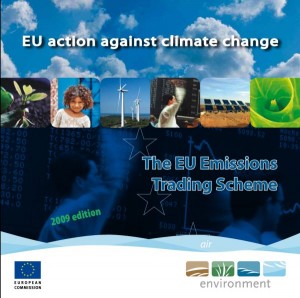Dickinson to Durban » Carbon Markets, Climate Change, Summer Reading Responses » What America Can (and should) Learn from Europe
What America Can (and should) Learn from Europe
By Timothy Damon ’12
America has a long and proud history of firsts – the first airplane, the first man on the moon, and so forth. This heritage makes it all the more surprising that the United States would give up its leadership in innovation when it comes to the world’s greatest problem: climate change. One of the largest examples is allowing Europe to establish the first-ever market mechanism for reducing greenhouse gas (GHG) emissions.
In 2005, the European Union (EU) implemented the Emissions Trading System (ETS), a cap-and-trade system aimed at reducing its GHG emissions. The principle of cap-and-trade (C&T) is relatively simple, and the idea actually came from a previous program the US EPA used to fight acid rain pollution. Basically the government sets an annual limit on GHG emissions and those who wish to legally emit must acquire permits (also called allowances) to cover their activity. These permits may either be given away or auctioned off. The “trade” in C&T refers to how permits will be bought and sold between different emitters depending on how much it would cost them to change their behaviors; if you can reduce your emissions more cheaply than the price of a permit, then you will make those changes and sell your extra permits to someone else for whom reducing emissions would be more expensive. The great cost-effectiveness of C&T comes from this high level of market-based flexibility.
The EU-ETS was devised to use this mechanism to help the EU meet its GHG reduction commitments under the Kyoto Protocol. The program began with a test run for the period of 2005 through 2008. Several problems emerged, as Ellerman and Jaskow explain. First, the absence of accurate emissions data at the start lead to the over-allocation of permits (defeating the point of the cap by allowing emissions to exceed the limit). Second, the market price of the permits experienced vast fluctuations due to pressures of global energy costs and the lack of accurate information upon which to base predictions. Third, energy companies gained substantial windfall profits because the permits were given away to them for free, even though they had a value on the market (though this did not stop the companies from raising prices for consumers). These problems complicated the trial phase of the EU-ETS, but they also provided important lessons – lessons that the United States could draw upon for crafting its own national C&T policy.
A C&T mechanism has emerged as a possible means for America to reduce its own GHG emissions. While the United States has lost the chance to pioneer this new system, coming second does mean the EU-ETS can serve as an example of what not to do here. The solutions are relatively straightforward: allow sufficient time before starting the program to collect accurate emissions data to avoid over-allocation, make permit cost projections and future policy impacts clear to minimize the price volatility caused by uncertainty, and give away fewer permits for free to reduce the extent of windfall profits (and generate more revenue for other uses). The Europeans have tested the waters for us. Now it is time for America to step up and implement its own improved C&T policy to contribute to global efforts to reduce GHG emissions and stimulate a vibrant new green economy.
For further reading:
Works Cited:
A. Denny Ellerman & Paul L. Joskow. The European Union’s Emissions Trading System in Perspective. Prepared for the Pew Center on Global Climate Change. May 2008. Massachusetts Institute of Technology.
Filed under: Carbon Markets, Climate Change, Summer Reading Responses · Tags: cap-and-trade, climate change, Emissions Trading System, ETS, EU, Europe, European Union, Timothy Damon









Hey Tim! Great post. One question: Did the ETS eventually work after the trial phase? And if not, will the failure of European cap-and-trade be helpful as a learning tool or will it just give skeptics the proof they need to hold off policies like it in the U.S.?
Hi Dani. Good questions; both of my “for further reading” links address them in more detail. To explain in short: the EU-ETS did get its act together after the trial period and has played a role in helping EU member states meet their Kyoto commitments. Thus, America can learn not only from what went wrong in the trial phase, but also what they did to rectify those issues. They have a workable model in place and I think cap and trade is definitely the mechanism the United States should use for its own mitigation policy (whenever we get around to enacting one, that is).
Tim,
I remember in class we had talked about the idea of a “hybrid” system. How do you think the United States could work with countries, like the EU, to form a cap-and-trade legislation mixed with another option, like the carbon tax? Like Dani mentions, there are skeptics for almost any market-based system that could possibly be put in place. Is it possible for the U.S. to form a policy that will work with the market, consumers, environmentalists, and legislators? Perhaps a hybrid cap-and-trade system is more pleasing. What do you think?